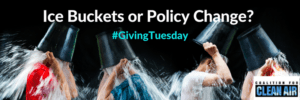Ice Buckets or Policy Change?
Remember the ALS Ice Bucket Challenge? The viral videos raised over $100 million for ALS in just one year. Impressive right?
Here’s what’s interesting: ALS opened a Public Policy Department in 1998. Since that time, the government has provided more than $950 million for ALS research.
The lesson from ALS: Improving and changing policies leads to long-term success.
In 2015, we wrote about the need to support environmental nonprofits. This Giving Tuesday, we wanted to talk about supporting nonprofits working on policy change. By creating systemic lasting transformation, these organizations stretch the impact of your donation well beyond its otherwise limited life.
The Coalition for Clean Air works in coalitions to achieve our mission. Today, we thought we’d take a moment to recognize these partnerships and their role in changing policy, by focusing on Charge Ahead California. Together, we’ve significantly changed the landscape for zero-emission vehicles.
Years before Tesla unveiled the roadster, electric cars in one form or another were available in the United States. Yet, with the declining price of oil and a regulatory backing system that favored gasoline, the electric vehicles would fall out of favor by the 1920s.
It wasn’t until 1992 that a commercially available electric vehicle, spurred by California’s Zero-Emission Vehicle (ZEV) Mandate, would become available to Californians. By 1999, around 5,000 EV1s were put into production and could be found on California’s roads. By 2003, however General Motors had recalled or retired nearly all these vehicles for a variety of reasons detailed in Who Killed the Electric Car. Automakers, it seemed, were unable or unwilling to sell electric vehicles.
Giving these early beginnings, it’s pretty remarkable to think that today more than 300,000 electric vehicles have been sold in California. This didn’t happen simply because automakers changed their minds. The ZEV Mandate, SB 1275 and subsequent legislation required automakers to sell zero-emission vehicles while helping to expand the market available for ZEVs. Reaching California’s ambitious goal of 1.5 million electric vehicles by 2025 may not be completely out of reach after all.
It can be challenging to make policy work emotionally engaging. You probably won’t jump for joy because you heard we successfully protected the Low Carbon Fuel Standard. But you just might if you knew that this policy kept asthmatic kids in school and mothers and fathers from having lung cancer. And you just might if you knew it was helping to prevent climate change.
On GivingTuesday, we want to thank the donors, advocates and volunteers who have helped us push for better policies. You make this work possible. Thank you for your support.
[share title=”Share This Post”]








